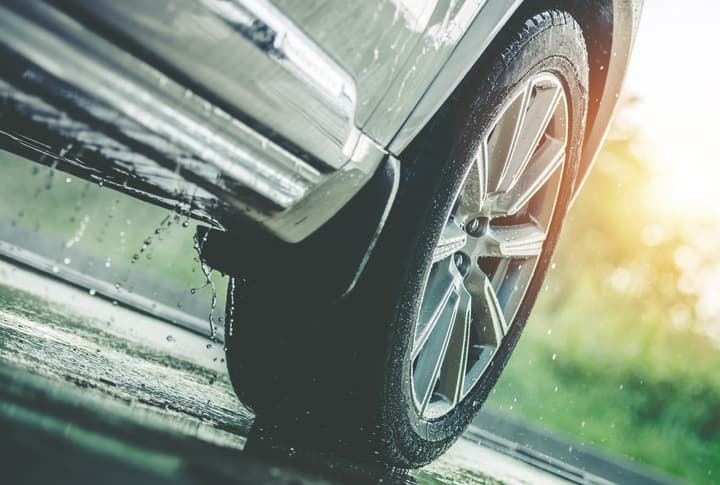Everything You Need To Know About Hydroplaning
From Why, To What To Do

Hydroplaning can be a terrifying experience. It stops you from being able to control which direction your car is going in, how fast it’s travelling, and how quickly you can stop it. But why does hydroplaning happen, and is there anything you can do about it? In short, yes.
Let’s first look at why hydroplaning occurs, with a quick Chill science lesson.
Hydroplaning happens when water gets in front of your tyres faster than the weight of your car can push it out the way.
Think of a typical puddle, for example. When you drive through that, the water sprays outwards, causing a dramatic splash and potentially soaking any nearby pedestrians. When you hydroplane, there is too much water for that to happen. The water has nowhere to go, or is being constantly replaced by new rain or excess surface water. This creates pressure beneath your wheels, lifting your car from the road and causing it to slide.
There are three main things that can cause hydroplaning:
- The Speed You’re Driving As your speed increases, the traction between your tyres and the road decreases. Just by driving a few km/h slower during winter, you can avoid hydroplaning and keep your car in good condition.
- Your Tyres’ Tread Worn tyres don’t grip as well as new ones. Reduced tread will increase your chances of hydroplaning, so you should get them checked before winter kicks in. A good tread should be at least 3mm deep.
- The Depth Of The Water While it’s possible to hydroplane on even a thin layer of water, deeper puddles are more likely to cause you problems, as there’s more water to move out the way. Resist the urge to cause a splash and drive around them when possible.
However, even now you know all of this, nature can still catch you out. On particularly icy or rainy days, even a careful driver with brand new tyres could find themself skidding.
So what should you do?
What Should You Do If Your Car Hydroplanes?
If your car starts hydroplaning, there are things you can do to help you regain control and limit your chances of a crash. The first thing to remember is not to panic - that way, the water wins.
Don’t Slam Your Brakes
Your first instinct might be to push your brake pedal, hard. But doing that could cause your car to skid out of control, as there’ll be nothing for your tyres to grip onto to make you stop.
Ease Off The Accelerator
Gradually take your foot off the accelerator to allow your car to slow down on its own. As your wheels slow, they’ll start to regain some traction, allowing you to gently use your brakes.
Keep The Steering Wheel Straight
Don’t make any sudden turns. Your wheels won’t be gripping onto the road, meaning any movements could cause you to skid sideways.
Turn Off Cruise Control, If You Have It
As soon as you notice your car hydroplaning, turn cruise control off, allowing your car to slow down.
Once you start to regain control of your car, you can slowly apply the break and begin to turn your steering wheel. After you’ve escaped the slippery patch, you might even want to pull over for a minute to get your composure back. Hydroplaning can be scary stuff, and no-one would judge you if you needed a moment to yourself.
Take the rest of your journey slowly to avoid it happening again.
How To Avoid Hydroplaning
If you play it safe, you can avoid hydroplaning all together. There are just a few things you need to do before heading out.
Check The Weather
If the weather forecast is for heavy rain, snow or ice, you can expect hydroplaning to be a potential problem en route. Adjust your driving accordingly, slowing down and taking corners at a wider angle. This will reduce the chance of your tyres losing their grip.
Slow Down
There’s no scientific speed that will stop your car from hydroplaning, but research does suggest a car traveling below 50km/h will be more likely to maintain traction even on a layer of ice or water. A car traveling over 80km/h won’t be able to do this as well.
Keep Your Tyres In Good Condition
New tyres do better on wet roads than worn ones. While the legal depth of your tyres’ tread is 1.6mm, it’s never a good idea to leave them to get to that level. Your annual service should look at the condition of your tyres, but as winter sets in you should also check they’re correctly inflated and not wearing thin.
Follow The Leader
Following a safe distance from the car in front of you will allow you to drive in its tracks. That means any water it has displaced will still be displaced for you, allowing you to maintain your grip on the road.
